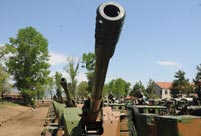

BEIJING, March 10 -- Fifty-six years after the 14th Dalai Lama fled abroad following a failed armed rebellion, the monk is still trying to destabilize Tibet, the southwestern Chinese autonomous region he once called home.
On Tuesday, flag-waving followers of the political exile protested in India and Nepal, urging China to end its"colonization" in the holy land.
The protests mark the anniversary of the Dalai Lama's failed rebellion in 1959, when a group of high-ranking Tibetan feudal serf owners attempted to preserve the serfdom -- a system as cruel as, if not worse than, European society in the Dark Ages.
Under the serfdom, the average life expectancy for Tibetans was no more than 36 years and wives who had extramarital affairs would have their noses and ears cut off as punishment.
The protests on the anniversary, which the Dalai Lama and his followers refer to as "Tibetan Uprising Day," came one day after a senior Tibetan official slammed his recent claim that the Tibetan Buddhism tradition of reincarnation should cease with his death, calling it "profanity against the Tibetan Buddhism."
Observers say termination of the reincarnation system that has been honored for hundreds of years would lead to a destabilized Buddhist region.
Beijing has repeatedly said the reincarnation of the Dalai Lama should follow strict historical convention and required religious rituals of the Tibetan Buddhism and should also be approved by the central government.
The latest confrontation came as Tibet ushers in an eventful year of pivotal anniversaries, challenges as well as development opportunities.
In 2015, the Dalai Lama will turn 80 years old, an occasion which has already been used by the monk as an opportunity to preach the de facto independence of Tibet.
"Over the past years, the 14th Dalai Lama and his followers have been trying to infiltrate their influence into the country," said Wangdu, a Tibetan deputy to China's top legislature. "That has made the situation in the border area very complicated and hard to control."
The lawmaker, also a senior official in Tibet's Nyingchi Prefecture, urged more efforts to fight the separatist force and safeguard stability.
In September, China will observe the 50th anniversary of the founding of the Tibet Autonomous Region, home to more than 3 million residents of different ethnic groups.
This year also marks the 30th anniversary of China sending the first Tibetan students to study in inland cities, to boost the development of the landlocked Himalayan region.
Both anniversaries will serve as reminders of how Tibet, once a backwater region, has developed over the past few decades.
"I used to live in a tent as a child. But now I am living in a spacious and well-illuminated Tibetan style building and do not have to worry about food and clothing any more," said Zhabsang, 51, an official who works with the Education and Sports Administration of Tibet's Prefecture of Nagqu, historically a grazing area."That's the proof of Tibet's development and progress."
"We should not forget the well-diggers when drinking from the well," Zhabsang, whose parents were born to be serfs, said.
On Monday, Padma Choling, chairman of the Standing Committee of the Tibet Autonomous Regional People's Congress, said that Tibetan people's sense of safety and sense of happiness are "both at a historical high."
Zhabsang's parents used to speak of days with insufficient food and clothes and arbitrary punishment by the serf owners. They were among the 1 million serfs, or 90 percent of the region's population at that time, who were merely regarded as "talking tools" under the feudal system.
In 1959, the Tibetan democratic reform ended the serfdom, emancipating the enslaved.
Since his escape, the Dalai Lama, who persistently preaches love and compassion, and his followers have instigated an array of incidents in pursuit of a separatist agenda, among them the deadly violence that hit Tibet in March 2008.
China's Tibetan areas see no repercussion of Tuesday's overseas protests. Chinese and foreign tourists in their high spirits are snapping photos of meditative lamas clad in crimson robes, twirling prayer wheels and chanting mantras.
Chinese authorities have said that the holy land, portrayed by the West either as the fictional "Shangri-la" on earth or the "hell under the Communist rule," needs development just like any other part of the world.
"The Tibetans do not want more violence like March 2008," said Menam Doje, a Tibetan member of the National Committee of the Chinese People's Political Consultative Conference, the country's top political advisory body, calling for stability and better life quality.
More economic growth potential is expected to be unleashed in Tibet this year, which has maintained double-digit growth over the past two decades.
In 2015, Tibet, still one of the poorest regions in the world's second largest economy, will aim to maintain economic growth at 12 percent, the same as last year and an eye-catching figure against the backdrop of China's flagging economy.
The growth momentum is expected to help the land, where about 10 percent of the regional population live under the national poverty line, to catch up with other areas and fulfill China's goal of building a moderately prosperous society by 2020.
Nearly 50 Tibetan lawmakers and political advisors who are convening in Beijing have submitted their proposals and suggestions for the region's development, including building more railways to boost connectivity and upgrade the irrigation system to promote agriculture that still dominates Tibet's economy.
 Attendants-to-be join Mr. & Miss Campus Contest
Attendants-to-be join Mr. & Miss Campus Contest China hosts overseas disaster relief exercise for the first time
China hosts overseas disaster relief exercise for the first time 20 pairs of twins who will become flight attendants in Sichuan
20 pairs of twins who will become flight attendants in Sichuan J-11 fighters in air exercise
J-11 fighters in air exercise PLA soldiers operating vehicle-mounted guns in drill
PLA soldiers operating vehicle-mounted guns in drill Beauties dancing on the rings
Beauties dancing on the rings Blind carpenter in E China's Jiangxi
Blind carpenter in E China's Jiangxi Top 10 highest-paid sports teams in the world
Top 10 highest-paid sports teams in the world In photos: China's WZ-10 armed helicopters
In photos: China's WZ-10 armed helicopters Obama is sowing discontent in S.China Sea
Obama is sowing discontent in S.China Sea Rescuers work through night to reach cruise ship survivors
Rescuers work through night to reach cruise ship survivors Driving through limbo
Driving through limbo Facing down MERS
Facing down MERSDay|Week